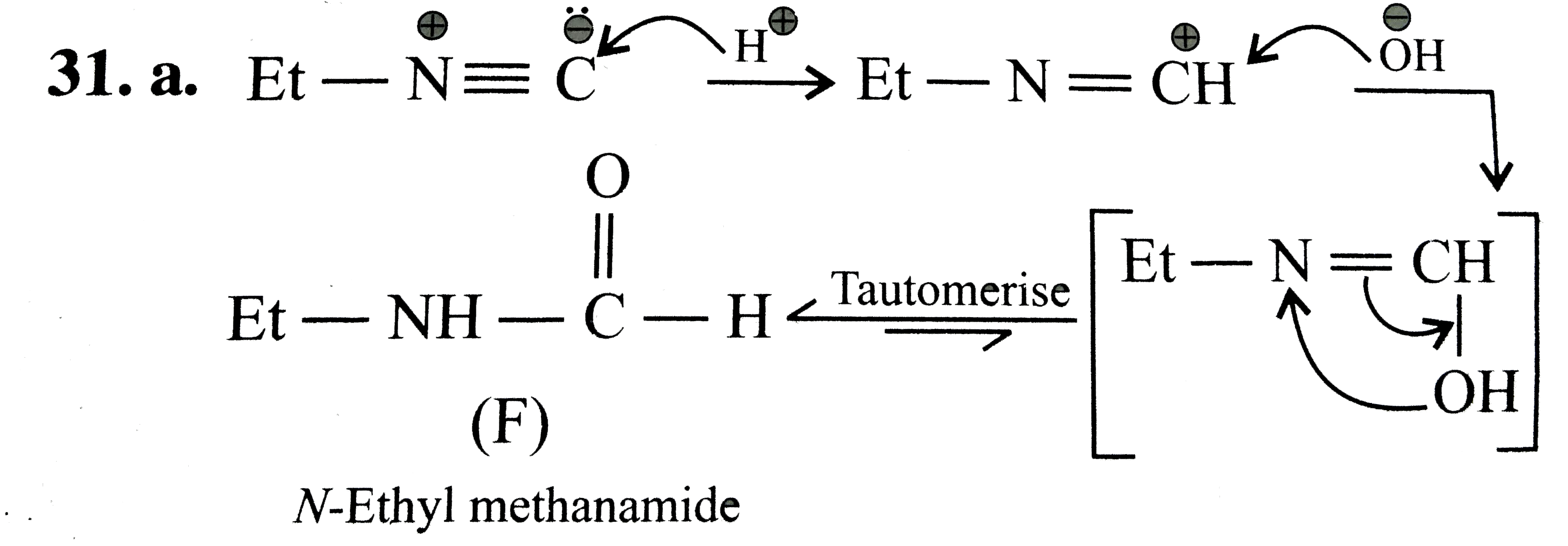
The compound (F) is :
N−Ethyl methanamide
N-Propylmethanamide
N-Ethylbutanamide
N-Propylpropanamide
The correct Answer is:A
(a) In an isocyanide, first an electrophile and then a nucleophile is added at the same C atom of (−⊕N≡ӨC) group to form a species which usually undergoes further transformations.
 .
.
Topper's Solved these Questions
- GRIGNARD REAGENTS AND ORGANOMETALLIC REAGENTSBook:CENGAGE CHEMISTRYChapter:GRIGNARD REAGENTS AND ORGANOMETALLIC REAGENTSExercise:Exercises (Multiple Correct)
Explore 16 Videos
- GRIGNARD REAGENTS AND ORGANOMETALLIC REAGENTSBook:CENGAGE CHEMISTRYChapter:GRIGNARD REAGENTS AND ORGANOMETALLIC REAGENTSExercise:Exercises (Single Correct)
Explore 47 Videos
- GRIGNARD REAGENTS AND ORGANOMETALLIC REAGENTSBook:CENGAGE CHEMISTRYChapter:GRIGNARD REAGENTS AND ORGANOMETALLIC REAGENTSExercise:Exercises (Subjective )
Explore 17 Videos
- GENERAL PRINCIPLES AND PROCESS OF ISOLATION OF ELEMENTSBook:CENGAGE CHEMISTRYChapter:GENERAL PRINCIPLES AND PROCESS OF ISOLATION OF ELEMENTSExercise:Archives (Subjective)
Explore 14 Videos
- NCERT BASED EXERCISEBook:CENGAGE CHEMISTRYChapter:NCERT BASED EXERCISEExercise:Nuclear Chemistry (NCERT Exercise)
Explore 29 Videos
Similar Questions
An acidic compound (A) , C4H8O3 , loses its optical activity on strong heating yielding (B), C4H6O2 , which reacts readily with KMnO4 . (B) forms a derivative (C) with SOCI2, which on reaction with (CH3)2NH gives (D). The compound (A) on oxidation with dilute chromic acid gives an unstable compound (E) which decarboxylates readily to give (F), C3H6O. The compound (F) gives a hydrocarbon (G) on treatment with amalgamated Zn and HCI. Give structures of (A) to (G) with proper reasoning.
View SolutionAn acidic compound (A) C4H8O3 loses its optically activity on strong heating yielding (B), C4H6O2 which reacts readily with KMnO4. (B) forms a derivative (C ) with SOCl2, which on reaction with (CH3)2NH gives (D). The compound (A) on oxidation with dilute chromic acid gives an unstable compound (E) hich decarboxylates readily to give (F), C3H6O. The compound (F) gives a hydrocarbon (G) on treatment with amalgamated Zn and HCl. Give the structures of (A) to (G) with proper reasoning.
View Solution
Knowledge Check
The compound (X) with M.F. C4H11N on treatment with HNO2 gives a tertiary alcohol with M.F. C4H10O. The compound (X) will give
ACarbylamine reactionBHofmann mustard oil reactionCDiazonium salt as intermediate with HNO2DGives 2-methyl-2-nitropropane on oxidation with KMnO4
Oxidation state of Fe in compound (F) isA+1B+2C+3D+4Four isomeric optically active compounds NaHCO3−−−−−→CO2(g)(A,B,C,D)(C4H8O3)
Compound (A)LAH−−→(E) (Archiral compound)
Compound (B)KMnO4−−−−−→orCrO3 Inert to oxidation.
Compound (C)−−−−−−−−→NaOI/H3O⊕CHI3(Yellowppt.)+Compound(F).
Compound (F) is :A B
B C
C D
D
An organic compound C8H10 (A) on treatment with alkaline KMnO4 gives a compound C6H6O4. (B) which on strong heating gives C6H4O3 (C). The compound (D) in dry benzene in presen of AlCl3 gives compound (E). The compound (E) on treatment with PCl5 followed by reaction with H2/Pd,BaSO4 gives compound (F). Identify (A) to (F).
View Solution(i) An aqueous solution of a white coloured compound (A) on reaction with HCl gives a white precipitate of compound (B).
(ii) (B) becomes soluble in chlorine water with the formation of (C)
(iii) (C) reacts with KI to give a precipitate which becomes solube in excess of it forming a compount (D). the compound (D) is used for detecting ammonium salts.
(iv) (B) and (C) both, on treatement with SnCl2 give a grey precipitate of (E).
(v) When conc. H2SO4 is added slowly into a mixture of cold solutions of (A) and FeSO4 is added slowly into a mixture of cold solutions of (A) and FeSO4, a brown ring of compound (F) is formed.
The oxidation number of FE in compound (F) is:
View SolutionCompound (x)(m.f=C7H8N), on reaction with NaNO2 and conc. HCl at O∘C followed by β− naphthol gives orange coloured dye. Compound (x) is :
View SolutionTwenty millilitres of a gaseous hydrocarbon (A) was exploded with excess of oxygen in eudiometer tube. On cooling, the volume was reduced by 50ml. On further treatement with KOH solution, there was a further contraction of 40 ml.

Compound (F) is:
View Solution
The compounds (F) are (G), resprctively, are:
View Solution

